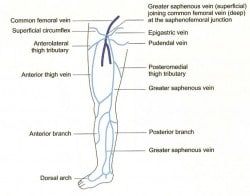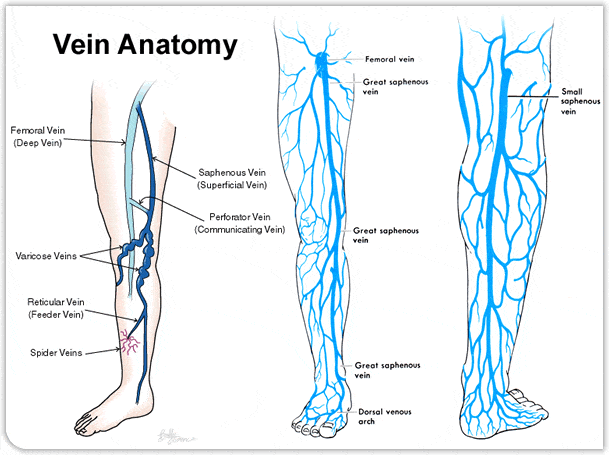After the arteries supply blood to the organs and muscles of the body, veins return deoxygenated blood back to the heart. The veins rely on a more passive and indirect mechanism to help aid in the return of blood to the heart. In the pelvis and lower extremities, blood in the veins has to fight gravity in order to flow in the correct direction. The lower extremity venous anatomy is divided into three interconnected systems: the deep and superficial venous systems and perforator veins.
Deep System

The deep system consists of the common femoral vein, the femoral vein, the deep femoral vein, the popliteal vein and the deep veins of the calf. The deep veins course through the center of the legs running parallel to the bones and drain the surrounding tissues, muscles and fascia. They also serve as an adjunctive draining system for the superficial system. Deep veins are usually resistant to internal derangement and in most circumstances do not get valve dysfunction. Most vein patients, therefore, have normal deep veins, which is fortunate because the deep venous system is responsible for 80-90% of lower extremity blood return.
Superficial Veins
 The main superficial veins are the greater saphenous and small (lesser) saphenous veins. There are multiple tributary veins that also drain into the great or small saphenous that can cause similar problems when they become abnormal. The superficial veins course in a compartment below the skin. They can be prone to dilation and valvular failure because they are not supported by the same muscular and facial structure as the deep veins. Almost all lower extremity venous insufficiency occurs in the superficial venous system.
The main superficial veins are the greater saphenous and small (lesser) saphenous veins. There are multiple tributary veins that also drain into the great or small saphenous that can cause similar problems when they become abnormal. The superficial veins course in a compartment below the skin. They can be prone to dilation and valvular failure because they are not supported by the same muscular and facial structure as the deep veins. Almost all lower extremity venous insufficiency occurs in the superficial venous system.
Perforator Veins

Perforator veins connect the deep and superficial venous systems. Perforator veins help shunt blood from the superficial veins to the deep veins. If the valves in the perforator veins are faulty, then flow is reversed causing deep venous blood to reflux into the superficial veins. This situation can cause severe superficial venous hypertension. Perforator insufficiency can be a common cause of lower extremity venous insufficiency and venous stasis ulcers.

